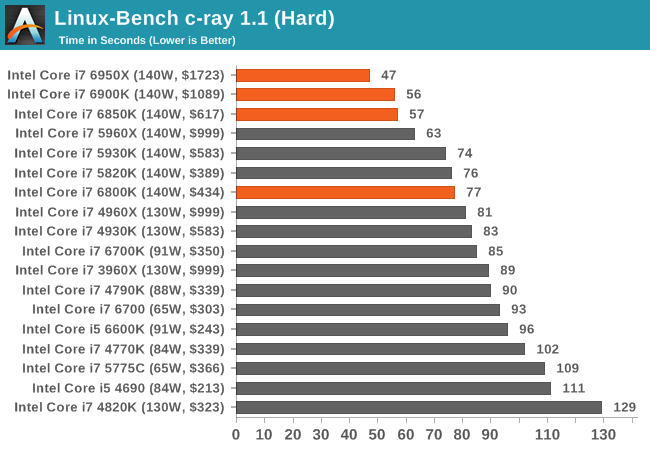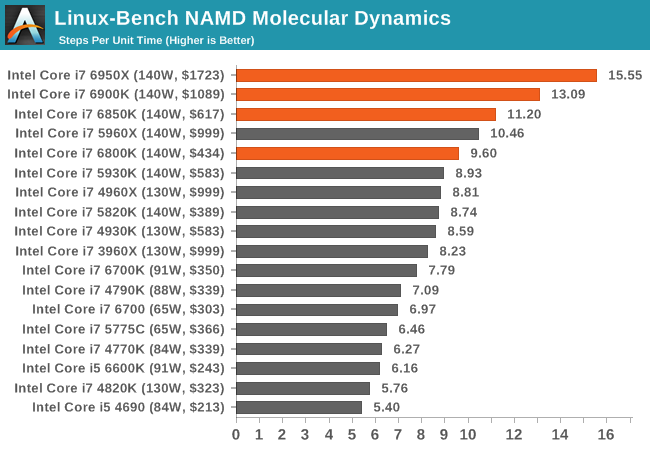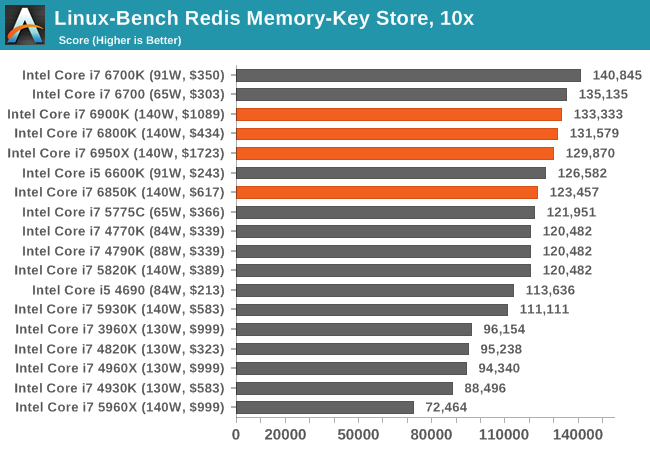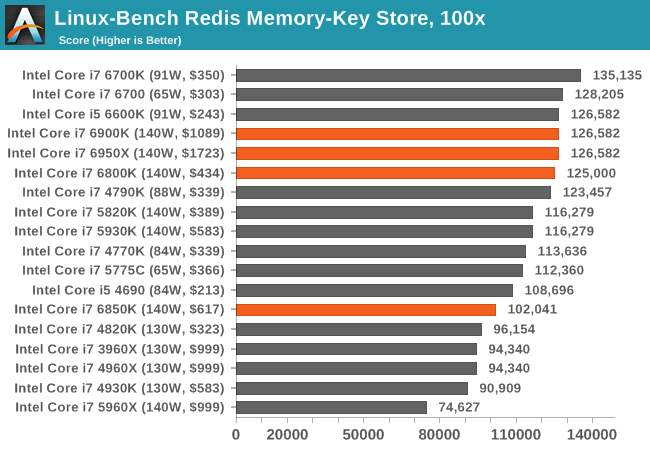The Intel Broadwell-E Review: Core i7-6950X, i7-6900K, i7-6850K and i7-6800K Tested
by Ian Cutress on May 31, 2016 2:01 AM EST- Posted in
- CPUs
- Intel
- Enterprise
- Prosumer
- X99
- 14nm
- Broadwell-E
- HEDT
Linux Performance
Built around several freely available benchmarks for Linux, Linux-Bench is a project spearheaded by Patrick at ServeTheHome to streamline about a dozen of these tests in a single neat package run via a set of three commands using an Ubuntu 11.04 LiveCD. These tests include fluid dynamics used by NASA, ray-tracing, OpenSSL, molecular modeling, and a scalable data structure server for web deployments. We run Linux-Bench and have chosen to report a select few of the tests that rely on CPU and DRAM speed.
C-Ray: link
C-Ray is a simple ray-tracing program that focuses almost exclusively on processor performance rather than DRAM access. The test in Linux-Bench renders a heavy complex scene offering a large scalable scenario.

NAMD, Scalable Molecular Dynamics: link
Developed by the Theoretical and Computational Biophysics Group at the University of Illinois at Urbana-Champaign, NAMD is a set of parallel molecular dynamics codes for extreme parallelization up to and beyond 200,000 cores. The reference paper detailing NAMD has over 4000 citations, and our testing runs a small simulation where the calculation steps per unit time is the output vector.

Redis: link
Many of the online applications rely on key-value caches and data structure servers to operate. Redis is an open-source, scalable web technology with a strong developer base, but also relies heavily on memory bandwidth as well as CPU performance.
[words]












205 Comments
View All Comments
sor - Sunday, June 5, 2016 - link
Actually, without those benchmarks I wouldn't have known for sure that we were GPU limited or that CPU makes almost NO difference (I might have expected a few more FPS). I also found it interesting that one game stood out as being CPU limited.IUU - Sunday, June 5, 2016 - link
All good and awesome but Intel's persistence on maintaining many-core cpus as niche expensiveproducts is a dangerous strategy, that may ultimately lead to its downfall.
If the IT world would like to see a renewed growth, high performance computing should enter the lives of ordinary Joes. Plenty of apps could make their way into our lives via many-core cpus.
Games with really improved AI, local voice and image recognition, reading comprehension, advanced text editing, advanced 3d printing, etc etc.
Looking down on the needs of ordinary people, is nonsensical, for it is "simple joes", the needs of which led to many core cpus and advanced gpus,that the hpc world so much uses. No further development can come if the same old strategy is not applied.
Motion2082 - Monday, June 6, 2016 - link
What other XEONs would you recommend for 8 core?craveable - Tuesday, June 7, 2016 - link
Seriously, guys. My personal opinion is to skip Broadwell-E, unless you absolutely cannot wait till Q1 2017. It's a very realistic timeframe when Skylake-E will be released. Some journalist spotted a Gigabyte motherboard on Computex 2016, suited for Skylake-E, sporting a new LGA 3647 socket and 6-channel memory controller. Memory bandwidth was always a crucial selling point of HEDT CPUs, so a transition from 4 (current) to 6 (Skylake-E) is an important incremental update.craveable - Tuesday, June 7, 2016 - link
However, further studying of leaks reveled that the next HEDT will be released in Q2 2017 and be probably named Skylake-X. In the leaked roadmap the Skylake-X availability timeframe is strangely the same as for Kaby Lake-X.craveable - Wednesday, June 8, 2016 - link
However #2, it's likely, that only server part of Skylake (EP) will get LGA 3647 and 6-channel controller. And Skylake-X will get 4 channels and the same LGA 2011-3.galta - Wednesday, June 8, 2016 - link
There is no point in saying that someone should skip upgrading. But for budget constraints, if your processor is not good enough, you have to upgrade; if it still performs as you need, you do not need to upgrade, even if new generation has the same price and 50% more performance.It is said that Intel is trying to milk us with a +USD1,700 cpu and that not all softwares (games) are fully optimized for more than 2-4 cores, but if you still run a i7 9xx series, it is probably time to upgrade, even if Broadwell-E increase in performance is not huge.
mapesdhs - Thursday, June 9, 2016 - link
That makes no sense. You state that BW-E performance increase isn't that much, while saying someone with an X58 6c should still upgrade anyway. What for? Why would someone on a constrained budget spend so much for so little speed gain? Given the platform differences, X58 users would probably benefit more from newer storage tech such as M2 and newer USB3x, in which case a 5930K on a decent board would be more sensible (or a 5820K if they don't need the PCIe lanes). What you've suggested just sounds like upgrading for its own sake. These days there are far more nuanced options available, especially from the used market.fifa17 - Sunday, June 12, 2016 - link
I'm putting a system together and I'm stuck between Core i7-6850K and Core i7-6800K on a ROG STRIX X99 GAMING motherboard. The only confusing point is the number of PCI Express Lanes which is 28 for i7-6800K and 40 for the other. I've pre ordered the ASUS ROG Strix GeForce® GTX 1080 and don't plan on adding a second one in the future. I'm also not getting an optical drive of any sort and no HDDs. Just a 1TB Samsung 850 PRO SSD. Which CPU should I choose? Any ideas about these components?legolasyiu - Wednesday, June 29, 2016 - link
It will be best to get Core i7 6850 with 40 lanes for GTX 1080 16x with 850 Pro.